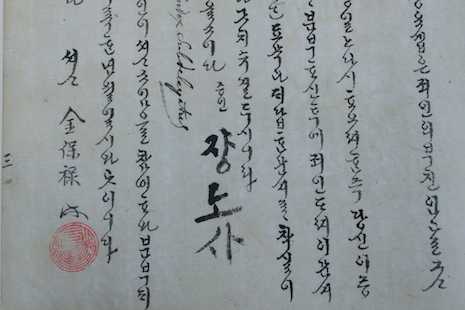
A page from the original manuscripts that form part of the Vatican archives on Korea’s 19th century martyrs.
The discovery of the original manuscripts that form part of the Vatican archives on Korea’s 19th century martyrs has redirected a spotlight on the Church’s tumultuous early history on the peninsula, more than a century after they were copied and translated.
The manuscripts, which run to several thousand pages, feature the recollections of people who came into contact with some 100 Catholics put to death as part of anti-Catholic suppression during the heavily Confucian Joseon period.
Befitting Christian notions of martyrdom, those killed are depicted as stoic in the face of the death, according Ahn Jae-won, a researcher at Seoul National University whose work led to the discovery.
“‘We go to death with a peaceful mind because we go to heaven’ — such a mind is repeatedly observed,” he said.
While the existence of the manuscripts themselves had been known, their significance as original versions of Vatican documents had not. It was only after Ahn published a book about the documents, called Congregatio Riti Processus 4858, 4859, 5279, that a colleague at another religious research institute noticed the similarities between the texts.
“People didn’t know there are Latin and French translations as official documents in the Vatican, that was the problem,” said Ahn. “So we have compared and now we have completed, so to say, a hole in the text.”
The texts, written in the Korean alphabet, were translated into French and Latin between 1882 and 1925 for the Vatican archives.
The testimonies were gathered by Korean martyr and saint, Hyeon Seok-mun, in the years after Gihaebakhae and Byeongobakhae, the names given to two nationwide crackdowns on Catholicism that occurred in 1839 and 1846, respectively.
Gihaebakhae and Byeongobakhae, which were bookended by several other waves of persecution during the century, were distinct in form and intent, according to Cha Gi-jin, a professor at the Yangeob Church Research Foundation.
While the former was a calculated move by “those in power that politically hated the Church,” the latter was a more spontaneous purge that saw the execution of Korea’s first priest, Andrew Kim Taegon.
From its introduction to Korea in the 1780s, Catholicism was treated with suspicion as it clashed with Confucian precepts such as hierarchical divisions of sex and class. Perceiving a threat to its authority and the social order, the ruling class soon banned expressions of the faith.
Killings began in 1791 with the execution of a number of Catholics who refused to perform the traditional ancestral rites. According to the Catholic Bishops’ Conference of Korea, more than 10,000 Catholics were killed between 1801 and 1866 alone.
Apart from their religious significance, the manuscripts also hold historical value, providing a portrait of Korea’s modernization and a comment on democracy and free expression that is notably ahead of its time, according to Ahn.
“The freedom of speech, the freedom of thought, the freedom of religion in the history of Korea, from the Three Kingdoms Era and Joseon, is just like the medieval age ... in Europe,” said Ahn. But the testimonies, he said, portray these freedoms as something “one should pay his life for”.
Ahn said one example of the relatively enlightened message in the texts is the portrayal of a crippled woman, whose voice would generally have been ignored at the time.
“She has no name, but she expresses her opinion without any fear,” he said. “So this is very important for explaining Korean democracy and tradition also.”
The content is also noticeable for its depiction of Korea, long subject to more powerful foreign forces, as an independent country, he added.
“When we read the Jesuit papers, from the 17th century to the 19th century, they described Korea as land that belonged to a Chinese province. But with this text, Korea was recognized as an independent kingdom. That also is very important, I think,” said Ahn.
The discovery has raised expectations for other finds related to the era’s historical record. One important part of that record is the work of Saint Marie-Nicolas-Antoine Daveluy, a French bishop who also documented Catholic persecution in Korea.
“I am excited for the originals of St A Daveluy’s Notes pour l'Histoiredes Martyrs de Corée and Notices des Principaux martyrs de Corée to be confirmed at the Vatican archives,” said Cha.


